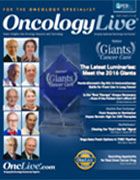Publication
Article
Oncology Live®
From Hospice to Remission: Hopes Remain High for CAR Therapies
Author(s):
Patients with advanced lymphoid malignancies have had few treatment options, particularly those with extensive, refractory disease. Allogeneic or autologous hematopoietic stem cell transplantation has been one life-prolonging and potentially curative option for these patients, but these procedures are associated with various toxicities and are not appropriate for all patients, with older adults and those with great- er disease burden often excluded as candidates.
Ian W. Flinn, MD, PhD

Ian W. Flinn, MD, PhD
Patients with advanced lymphoid malignancies have had few treatment options, particularly those with extensive, refractory disease. Allogeneic or autologous hematopoietic stem cell transplantation (HSCT) has been one life-prolonging and potentially curative option for these patients, but these procedures are associated with various toxicities and are not appropriate for all patients, with older adults and those with great- er disease burden often excluded as candidates.
Moreover, once intensive chemotherapy or HSCT fails, there are often no options left, which has spurred researchers to find new cellular strategies to target advanced hematologic malignancies.
One such novel strategy currently in development on the immunotherapy front is the use of chimeric antigen receptor (CAR) T cells, which has enabled some patients to move from hospice candidate to remission.
During a recent OncLive Peer Exchange panel titled “Immunotherapy Use in Advanced Lymphoid Malignancies,” experts in the field provided a comprehensive overview of CAR T-cell therapies, including how they work, their toxicities, key clinical trial results, and their role in clinical practice.
Although CAR T-cell therapies have been in development for decades, recent advancements in how these treatments are designed have enabled them to become more efficacious and are bringing them closer to FDA approval, generating considerable excitement.
CAR T-Cell Therapy Overview
Moderator Ian W. Flinn, MD, PhD, said he is impressed about the progress being made. “It is not just the clinical results which are fantastic but also just the logistical advancement that we’ve had in terms of taking these out of a single academic center and being able to do it in large trials across the United States,” he said.CAR T-cell therapies use reengineered T cells to target antigens on the surface of cancerous cells. The T cells are collected via apheresis and then sent to a facility where they are genetically engineered to produce CARs on their surface.
The reengineered cells are then expanded in the laboratory until they reach sufficient numbers, then frozen, and sent back to the treatment center for infusion. In many cases, patients receive a brief course of 1 or more lymphodepleting chemotherapeutic agents before the CAR T cells are infused. “The lymphodepleting chemotherapy drives down the existing lymphocytes that are within the body and creates space for those transferred T cells,” explained Frederick L. Locke, MD.
The CAR design is where CAR T-cell therapies differ. Although all CAR designs contain an antigen-recognition domain and a signaling domain that cause the T cells to activate, the first-generation CARs have only 1 signaling domain, whereas second-generation CARs have a costimulatory signaling domain, and third-generation CARs have 2 costimulatory signaling domains, providing additional signals to activate T cells.
Additionally, while all CARs use the CD3-zeta intracellular signaling domain, the costimulatory domains among the second- and third-generation treatments vary. “Several different costimulatory domains are in use today,” said Locke. “There’s a CD28 and a 4-1BB costimulatory domain.”
The costimulatory domains in use are not foreign to T cells. “[CD28 and 4-1BB] normally would be a receptor on the T cell that would receive a second signal through a unique ligand, but in the context of the CAR, they’re basically artificially delivered through the same genetic construct,” said Krishna V. Komanduri, MD.
“So, theoretically, the kinetics of engagement of the second signal through these receptors can vary and, therefore, when you deliver it artificially, the cell can react differently,” he noted.
CAR T-Cell Therapy Toxicities
He indicated that ongoing studies will provide better insights on how these costimulatory signals affect response in different patients and what effects they have on the cellular level in different hematologic malignancies.Although CAR T-cell therapies are generally well tolerated the first few days following injection of the reengineered T cells, many patients develop cytokine release syndrome (CRS), which can be life-threatening but also serves as an indicator of efficacy. CRS generally manifests as high fevers, chills, hypotension, and hypoxia.
“This can be a very toxic treatment,” said Locke. “You need a specialized team that’s familiar with those toxicities.” He noted that his institution created a team with hematologic malignancy and transplant physicians for these toxicities, which are reversible if handled correctly.
Additionally, some patients progress to develop neurological complications, although this is generally a rarer complication. “These patients can become comatose, have to be intubated, experience seizures, and have speech and communication problems,” said Andre Goy, MD, MS.
“They can get kind of a ‘locked-in syndrome,’ where they’re awake and appear alert but can’t answer questions,” added Locke, indicating that the toxicity is similar to neurologic adverse effects seen with blinatumomab, a bispecific T-cell engager approved in acute lymphoblastic leukemia.
As with CRS, CAR T-cell—related neurological toxicity is also generally completely reversible; however, its pathophysiology remains poorly understood. “We know that CAR T-cells can be found within the central nervous system, or within cerebrospinal fluid, but the cause of neurological toxicity is still being looked at,” said Locke.
Because CAR T-cell therapies are still being investigated and efficacy of response is tied to the proliferation of T cells, which is also the cause of toxicity, a major challenge is determining when and how to intervene when toxicities manifest.
“One thing we don’t know is what degree of expansion is actually needed,” said Komanduri.“Intellectually, persistence seems necessary, but we also know from NCI data that there are patients who have had durable responses with no persistence... I think we’re really early in understanding when we can successfully abort and how to balance the toxicities from the clinical effects,” he said.
Once the decision is made to intervene, steroids, tositumomab, and other treatments can be considered, although use of high-dose steroids was discouraged by the panelists. They discussed numerous strategies that are in development or being investigated to avoid or reduce toxicities, such as CAR T-cell therapies with a built-in suicide gene that serves as a safety switch, enabling removal of inappropriately activated CAR T-cells, as well as coadministered agents that would adjust the number of T cells or their activity levels.
Noteworthy Clinical Trials
“We need correlative data before we know how to tweak the response to maximize the good effects,” said Komanduri. Currently, it remains an individualized decision that is best made by a treatment team familiar with CAR T-cell therapies and their toxicities.The panelists discussed several clinical trials that they are involved with that have shown CAR T-cell therapies to have considerable promise, including Kite Pharma’s ZUMA-1 and Juno Pharmaceutical’s ROCKET.1,2
ZUMA-1 administered anti-CD19 CAR T-cells with the CD28 costimulatory domain to 62 patients.1 The objective response rate for the entire population was 79% and the complete remission rate (CR) was 52%, according to interim results that Kite Pharma released in September.
In earlier results, 3 of 5 responders had “durable CRs out to 9 months and counting,” said Locke, a key study investigator. “What’s really important about understanding this trial is that it included patients with diffuse large B-cell lymphoma and primary mediastinal and transformed follicular lymphoma, with only those with truly chemorefractory disease enrolled,” Locke said.
He said previous data have shown best overall response rates of no more than 30% and a CR of 8% to 10% in patients who did not respond to their last chemotherapy or relapsed after HSCT, making ZUMA-1 results quite remarkable.
One patient in ZUMA-1 died of an intracranial hemorrhage that was deemed unrelated to CAR T-cell treatment, but was attributed to the precursory lymphodepleting chemotherapy in the setting of the patient’s overall poor health. “In the other patients, all toxicities were reversible, including CRS and neurologic toxicity, which affected all patients on some level,” said Locke. In the study, CRS and neurotoxicity were managed with supportive care, α-IL6R, and steroids.1
The ROCKET study, which is still ongoing, is assessing CD19-directed CAR T-cell therapy with the CD28 costimulatory domain (JCAR015) in the setting of relapsed/refractory B-cell acute lymphocytic leukemia.2
At the 2016 ASCO Annual Meeting, investigators reported CRs of 90% in the minimal disease cohort (n = 20) and 77% in the morphologic disease group (n = 30).2 The minimal residual disease—negative CR (MRD-CR) rates were 78% in the minimal disease cohort and 90% in the morphologic disease group, indicating potent antitumor efficacy regardless of pretreatment disease burden.2
Shortly after the meeting, the trial was briefly put on hold after 2 patient deaths from cerebral edema (a third patient died earlier from the same complication), which was ultimately attributed to the addition of fludarabine to the preconditioning regimen.3 The FDA enabled the trial to continue with use of cyclophosphamide preconditioning alone.3
Juno Pharmaceuticals is currently enrolling patients to assess a CAR T-cell regimen (JCAR017) in patients with relapsed/refractory B-cell non-Hodgkin lymphoma (NCT02631044).
Integrating CARs Into Clinical Practice
“The Juno B-cell lymphoma study uses a 4-1BB domain,” said Komanduri, who is involved with the Juno studies. “There are 2 planned infusions of the CAR-T cells, and you basically have a dealer’s choice chemotherapy or supportive care once the patient is enrolled during the time manufacturing happens, and then you have lymphode-pleting chemotherapy, assuming that the patient has acceptable performance status and toxicity. Following the first cellular infusion, there’s a dose-escalated second infusion.”CAR T-cell therapies are currently only available via clinical trials, but the panelists agreed that when they enter wider distribution, they will have to be administered at specialized centers.
“There has to be involvement of a cellular apheresis center, cell therapy laboratory, and high-level nursing, as well as access to the kinds of sophisticated services that are typically found in transplant centers,” said Komanduri. “It’s not to say that it can’t happen outside of a transplant center, but I think you have to have those resources.”
n the meantime, the panelists urged clinicians to consider encouraging patients to enroll in clinical trials. “If you have a patient who is refractory to standard therapies, and there is a center enrolling nearby, this treatment definitely needs to be looked at...because it gives the patient opportunities,” said Goy.
Among the first responders, we have 3 heavily pretreated refractory follicular lymphoma patients who have been in remission for more than 5 years,” he said. Although CAR T-cell therapies are far from perfect and many challenges remain, it is clear they are providing hope where little hope existed before.
References
- Ghobadi A, Locke FL, Neelapu SS, et al. Updated phase I results from ZUMA-1: a phase I-II multicenter study evaluating the safety and efficacy of KTE-C19 (anti-CD19 CAR T cells) in subjects with refractory aggressive non-Hodgkin lymphoma (NHL) [abstract]. In: Proceedings of the 107th Annual Meeting of the American Association for Cancer Research; April 16-20, 2016; New Orleans, LA. Abstract CT135. doi:10.1158/1538-7445.AM2016-CT135.
- Park JH, Riviere I, Wang X, et al. Impact of disease burden on long-term outcome of 19-28z CAR modified T cells in adult patients with relapsed B-ALL. Presented at: 2016 ASCO Annual Meeting; June 3-7, 2016; Chicago, IL. Abstract 7003.
- Inman S. FDA lifts clinical hold on phase II trial of JCAR015 in ALL. OncLive.com. Published July 12, 2016. Accessed October 16, 2016. https://goo.gl/oCYhFt.



























%20(2)%201-Recovered-Recovered-Recovered-Recovered-Recovered-Recovered-Recovered-Recovered-Recovered-Recovered-Recovered-Recovered-Recovered-Recovered-Recovered-Recovered-Recovered.jpg?fit=crop&auto=format)
%20(2)%201-Recovered-Recovered-Recovered-Recovered-Recovered-Recovered-Recovered-Recovered-Recovered-Recovered-Recovered-Recovered-Recovered-Recovered-Recovered-Recovered-Recovered.jpg?fit=crop&auto=format)
